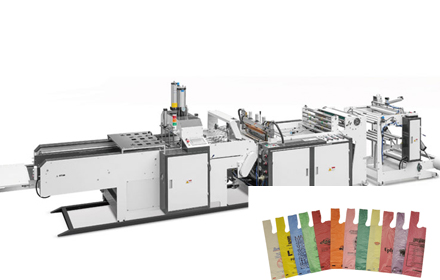In the fast-paced packaging industry, efficiency and precision are paramount. Bag making machines have revolutionized the production of flexible packaging, catering to diverse needs across retail, food, healthcare, and logistics sectors. This article explores four specialized types of bag making machines – T-shirt Bag Making Machines, Bottom Sealing Bag Making Machines, Bags on Roll Making Machines, and Side Sealing Bag Making Machines – to help businesses understand their unique functionalities and applications.
T-shirt bag making machines are engineered to produce lightweight, handle-equipped plastic bags resembling the shape of a T-shirt. These machines excel in high-volume production for supermarkets, boutiques, and convenience stores.
How They Work:
Rolls of polyethylene (LDPE/HDPE) film are fed into the machine.
Precision dies cut handles while heat seals form the bag's bottom and sides.
Advanced models integrate printing units for custom logos or branding.
Why Choose Them:
Ideal for lightweight, reusable carrier bags.
Supports eco-friendly materials like recycled or biodegradable films.
Output: 50-150 bags/minute, depending on size and complexity.
These Bottom Seal Bag Making Machines specialize in creating bags with reinforced flat bottoms, essential for stabilizing products like pet food, fertilizers, or bulky items.
Key Features:
Heat-sealing technology ensures leak-proof bottoms.
Compatible with multi-layer laminates (e.g., PET/AL/PE for moisture resistance).
Optional gusseting for expandable sidewalls.
Industries Served:
Agriculture, chemicals, and food processing.
Ideal for automated filling lines due to uniform bag dimensions.
Designed for producing continuous rolls of pre-opened bags, these machines are a game-changer for industries requiring rapid, automated packaging.
Operational Workflow:
Film is perforated and wound into rolls with pre-sealed sides/bottoms.
Bags are separated by micro-perforations for easy dispensing.
Advantages:
Reduces labor costs in pharmacies, bakeries, or e-commerce fulfillment centers.
Enables "pick-and-place" automation with robotic systems.
Side sealing machines create bags sealed along one or both edges, offering flexibility for unique shapes and materials.
Applications:
Produce stand-up pouches with zippers or spouts.
Medical packaging (sterile barrier systems).
Food-grade bags for snacks, coffee, or frozen goods.
Innovations:
Servo-driven systems for precision sealing.
Integration with vision systems for quality control.
Material Compatibility: Ensure the machine supports your film type (e.g., biodegradable PLA, woven PP).
Output Speed: Match production capacity with demand (e.g., Bags on Roll machines prioritize speed).
Automation Level: Semi-automatic vs. fully automated models with IoT-enabled monitoring.
Sustainability: Opt for energy-efficient designs and adaptability to compostable materials.
As circular economy goals gain traction, manufacturers are prioritizing:
AI-Powered Optimization: Reducing material waste through predictive adjustments.
Hybrid Machines: Combining multiple sealing technologies (e.g., side + bottom sealing).
Modular Designs: Quick-change components for small-batch custom orders.
Whether you’re packaging fresh produce or industrial components, understanding these machines’ capabilities ensures smarter investments. By aligning technology with operational needs, businesses can enhance productivity while meeting evolving sustainability standards.
Explore the right bag making solution today – where innovation meets functionality!

GET A QUOTE